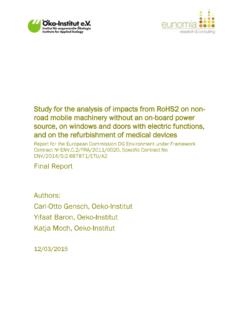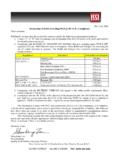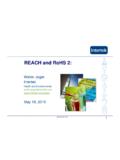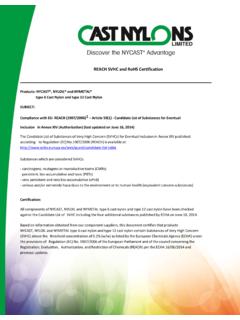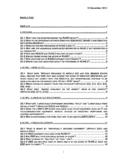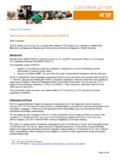Transcription of Study for the review of the list of restricted …
1 Study for the review of the List of restricted Substances under rohs 2 Analysis of Impacts from a Possible Restriction of Several New Substances under rohs 2 Final Version Authors: Carl-Otto Gensch, Oeko-Institut Yifaat Baron, Oeko-Institut Markus Blepp, Oeko-Institut Dirk Bunke, Oeko-Institut Katja Moch, Oeko-Institut Report for: The EUROPEAN COMMISSION DIRECTORATE-GENERAL ENVIRONMENT Directorate A - Green Economy Prepared by: Oeko-Institut Freiburg Head Office Box 1771 79017 Freiburg, Germany Street Address Merzhauser Str. 173 79100 Freiburg, Germany Tel.:+49 (0) 761 4 52 95-0 Fax +49 (0) 761 4 52 95-288 Web: Approved by: Adrian Gibbs, Eunomia .. Contact Details Eunomia Research & Consulting Ltd 37 Queen Square Bristol BS1 4QS United Kingdom Tel.: +44 (0)117 9 172250 Fax: +44 (0)8717 142942 Web: Disclaimer Eunomia Research & Consulting and Oeko-Institut have taken due care in the preparation of this report to ensure that all facts and analysis presented are as accurate as possible within the scope of the project.
2 However, no guarantee is provided in respect of the information presented, and Eunomia Research & Consulting and Oeko-Institut are not responsible for decisions or actions taken on the basis of the content of this report. review of the List of restricted Substances under rohs 2 Contents Background and objectives .. 1 Approach .. 2 Project set-up .. 3 substance prioritisation .. 4 Overview of the substances reviewed .. 4 REACH and CLP Regulation .. 5 REACH .. 5 CLP Regulation .. 6 substance review structure .. 8 Tris(2-chloroethyl) phosphate (TCEP) .. 10 Classification .. 10 Uses and quantities .. 10 Contributions of stakeholders .. 11 Summary .. 12 12 Dibromo-neopentyl-glycol .. 13 Classification .. 13 Uses and quantities .. 13 Contributions of stakeholders .. 14 Summary .. 15 15 2,3-dibromo-1 -propanol (Dibromo-propanol) .. 16 Classification .. 16 Uses and quantities .. 16 Contributions of stakeholders .. 16 Summary.
3 17 17 Antimony trioxide .. 18 Classification .. 18 Uses and quantities .. 18 Contributions of stakeholders .. 19 Summary .. 22 23 Diethyl phthalate (DEP).. 24 Classification .. 24 Uses and quantities .. 24 i review of the List of restricted Substances under rohs 2 Contributions of stakeholders .. 24 Summary .. 25 References .. 25 Tetrabromo-bisphenol A .. 26 Classification .. 26 Uses and quantities .. 26 Contributions of stakeholders .. 27 Summary .. 30 References .. 30 Medium chained chlorinated paraffins (MCCP), C14 C17: alkanes, C14-17, chloro .. 31 Classification .. 31 Uses and quantities .. 32 Contributions of stakeholders .. 32 Summary .. 35 References .. 35 Polyvinyl-chloride (PVC) .. 36 Classification .. 36 Uses and quantities .. 36 Contributions of stakeholders .. 37 Summary .. 42 References .. 42 Nickel sulphate and nickel bis(sulfamidate)/nickel sulfamate .. 43 Classification .. 43 Uses and quantities.
4 44 Contributions of stakeholders .. 45 Summary .. 47 References .. 47 Beryllium metal .. 48 Uses and quantities .. 48 Contributions of stakeholders .. 49 Summary .. 51 References .. 51 Beryllium oxide (BeO) .. 52 Uses and quantities .. 52 Contributions of stakeholders .. 52 Summary .. 53 References .. 53 ii review of the List of restricted Substances under rohs 2 Indium phosphide .. 54 Classification .. 54 Uses and quantities .. 54 Contributions of stakeholders .. 55 Summary .. 56 References .. 56 Di-arsenic pentoxide ( arsenic pentoxide; arsenic oxide) and di-arsenic 57 Classification .. 57 Uses and quantities .. 57 Contributions of stakeholders .. 58 Summary .. 58 References .. 59 Cobalt dichloride and cobalt sulphate .. 59 Classification .. 59 Uses and quantities .. 60 Contributions of stakeholders .. 62 Summary .. 65 References .. 65 Cobalt metal .. 66 Classification .. 66 Uses and quantities .. 66 Contributions of stakeholders.
5 67 Summary .. 68 References .. 69 Nonylphenol .. 69 Classification .. 69 Uses and quantities .. 70 Contributions of stakeholders .. 71 Summary .. 71 References .. 71 General contributions of stakeholders .. 72 Priority recommendations .. 74 Appendix 1: DIBP rohs substance Assessment Dossier .. 80 iii review of the List of restricted Substances under rohs 2 Abbreviations ATO .. Antimony trioxide AUBA .. Austrian Umweltbundesamt GmbH CAS .. Chemical Abstract Service CMR .. Carcinogenic, Mutagenic or toxic for Reproduction DBP .. Dibutyl phthalate DEHP .. Bis(2-ethylhexyl)phthalate DEP .. Diethyl phthalate DIBP .. Diisobutyl phthalate ECHA .. European Chemicals Agency ECPI .. European Council for Plasticisers and Intermediates ESIS .. European chemical Substances Information System EEE .. Electrical and Electronic Equipment EPA .. Environmental Protection Agency ESIS .. European Chemical Substances Information System HPVC .. High Production Volume Chemical IPPC.
6 Integrated Pollution Prevention and Control Directive JBCE .. Japanese Business Council in Europe Kt .. Kiloton LPVC .. Low Production Volume Chemical MCCP .. Medium Chained Chlorinated Paraffins PBT .. Persistent, Bioaccumulative and Toxic Substances OSPAR .. Oslo and Paris Conventions for the Protection of the Marine Environment of the North-East Atlantic PCB .. Printed Circuit Boards PVC .. Polyvinylchloride Risk Assessment Committee REACH .. Registration, Evaluation, Authorisation and Restriction of Chemical Substances TMC .. Test & Measurement Coalition SCCNFP .. Scientific Committee on Cosmetic Products and Non-Food Products Committee for Socio-economic Analysis Substitute It Now! List SVHC .. substance of Very High Concern UPE .. Unsaturated Polyester vPvB .. very Persistent and very Bioaccumulative Substances WEEE .. Waste Electrical and Electronic Equipmentiv review of the List of restricted Substances under rohs 2 Background and objectives The rohs Directive (2002/95/EC) ( rohs 1) has been recast and has now become Directive 2011/65/EU that entered into force on 21 July 2011, repealing Directive 2002/95/EC on 3 January 2013.
7 The rohs Directive (2011/65/EU) on the restriction of the use of certain hazardous substances in electrical and electronic equipment requires that EEE placed on the market, including cables and spare parts for its repair, its reuse, updating of its functionalities or upgrading of its capacity, does not contain the substances listed in Annex II ( lead, mercury, cadmium, hexavalent chromium, polybrominated biphenyls and polybrominated diphenyl ethers). Directive 2011/65/EU, referred to as rohs 2, sets the rules for amending the list of restricted substances in Article 6(1). A review and amendment of Annex II is to be considered by the Commission before 22 July 2014, and periodically thereafter. In preparation of the 2014 review , the Austrian Umweltbundesamt GmbH (AUBA) conducted a first Study that started in 2012 and ended at the beginning of 2014. The outcome of this Study is a methodology for the identification, prioritisation (pre-assessment) and assessment of potentially relevant chemical substances in AUBA also applied this methodology and produced an inventory of substances, a 24 entries priority substance list, and detailed dossiers for the four substances prioritised already in rohs 2, Recital 10.
8 These substances are HBCDD (brominated flame retardant), DEHP, BBP and DBP (three phthalate plasticisers), which also scored the highest ranking (together with seven other substances) in the AUBA pre-assessment. The Study also showed that in some cases a selective ban of a substance from a larger substance group might drive industry towards the use of a problematic alternative from the very same group ( substituting one brominated flame retardant for another). This is why the phthalate DIBP, which ranks highest according to the AUBA findings and is a standard substitute for DBP, was also identified for performing an assessment in the current Study . With the contract No. ENV/2013 implementing Framework Contract No. , a consortium led by Eunomia Research & Consulting has been requested by DG Environment of the European Commission to provide additional information concerning a further substance to be assessed as a 1 provides download documents for the Study for the review of the List of restricted Substances under rohs 2 Directive commissioned by DG Environment (European Commission): Final report; Annex 1 Manual on the Methodology for Identification and Assessment of Substances for Inclusion in the List of restricted Substances (Annex II) under the RoHS2 Directive.
9 Annex 2 rohs Annex II dossier Template Annex 3 EEE substance inventory Annex 4 Priority List Annex 5 rohs Annex II dossier for HBCDD Annex 6 rohs Annex II dossier for DEHP Annex 7 rohs Annex II dossier for BBP Annex 8 rohs Annex II dossier for DBP 1 review of the List of restricted Substances under rohs 2 candidate for addition to Annex 2 of the rohs Directive as well as prioritisation of a first shortlist of further substances. The work has been undertaken by Oeko-Institut, and peer reviewed by Eunomia Research & Consulting. The work has been requested in view of supporting the review of the list of restricted substances under rohs 2. Summarising the above, the objectives of this project can be outlined as follows: Prepare a substance assessment of Diisobutylphthalat (DIBP), based on the methodology (template) for substance assessment prepared by the Austrian Umweltbundesamt GmbH; Provide input concerning quantitative usage data for the 21 priority substances in EEE identified by the Austrian Umweltbundesamt GmbH, or where this is not possible, a magnitude ranking, with a view to a refined prioritisation for future review cycles.
10 The report includes the following Sections: Section Approach Section Project set -up Section substance prioritisation Section Appendix 1: DIBP rohs substance Assessment Dossier Approach The initial approach to the various tasks included the review of publically available information from the following sources: European Chemicals Agency (ECHA): Documents provided during processes to address chemicals of concern; information provided by the Registered substance Database2 and the Classification & Labelling Inventory Database3; Other EU Documents EU Risk Assessment Reports, Reports from the EU COM; Industry information, available on the internet, mainly published on websites of industry associations; Results from the Oeko-Institut Study in 2008 on Hazardous Substances in Electrical and Electronic Equipment, not Regulated by the rohs 2 3 4 Oeko-Institut (2008): Study on Hazardous Substances in Electrical and Electronic Equipment, Not Regulated by the rohs Directive by Gro , R.
